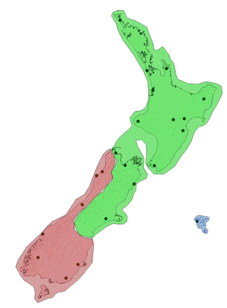|
|
| Michael Gemmell m.r.gemmell@massey.ac.nz |
| About myself: |
I started my academic career with a zoology degree at Otago University NZ. Following this I had a position doing fieldwork for a study on the Grand and Otago Skinks at Macraes flat near Dunedin. I went overseas for a bit and came back and tried my hand at wine making for a while. Moved to Wellington and got a job as a conservation officer at Zealandia. During this time decided it was time to head back to university. I did a PGdipsci at Victoria University that lead to being offered the Te Papa MSc molecular systematics scholarship. For this
I did a study looking at the late Quaternary Phylogeography of Pseudopanax crassifolius. This study was a population genetics follow on from Perrie and Sheppard (2011) using microsatellite data. The goal was to infer what has happened to the species since the last glacial maximum approximately 18000 years ago. I suspect P. crassifolius was restricted to the northern part of the South Island and the North Island and remained fairly ubiquitous when the climate was colder. Since the LGM it has spread back into the southern South Island in a leading edge fashion. This is a bit of a speculation because there is not a strong genetic signal. If strong signal had been present at some stage it may have subsequently been lost through gene flow or perhaps never established because of high connectivity between populations, a consequence of the widespread almost continuous distribution. The main conclusion is that the pattern is very different to that found in Pseudopanax ferox by Perrie and Shepherd, as would be expected by looking at the current distributions of the two species. |
 |

|
Population clusters of of Pseudopanax crassifolius. Possibly indicating LGM survival. Present in green areas and extirpated from red areas. Blue is Pseudopanax chathamicus. |
 |
| My research: |
|
At the 2012 NZ molecular ecology conference I met Mary Morgan-Richards who mentioned an upcoming PhD position, we kept in touch and eventually I was offered a position investigating the mode of evolution in New Zealand marine molluscs.
For this programme we will be combining genetic analyses with geometric morphometric analysis of shell shape of some Neogastropod molluscs found around New Zealand and represented in the fossil record, with the broad aim of testing some predictions of Punctuated Equilibria.
My focus will be the Genus Amalda. This is a genus which has morphological stasis inferred from the fossil record, this being one of the main premises of Punctuated Equlibrium. We want to do population level sampling of the species in this genus to get a better idea of the population dynamics and the species delimitation. Does the genetic data support current species definitions? Is there any connectivity between species and populations through hybridisation and introgression. If the species boundaries are strong and can be extended into the fossil record this will give us some confidence of our interpretations of the fossil record, and therefore the applicability of PE as explanation for the mode of evolution in this group. Genetic data will be used to test the association of cladogenesis with morphological change in the fossil record. |

Extant Amalda (above), fossil Amalda (below)

|
|
| |
|
|
|
|